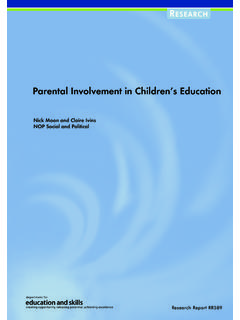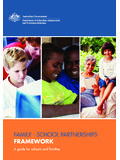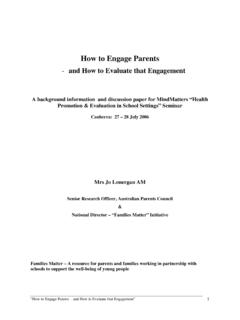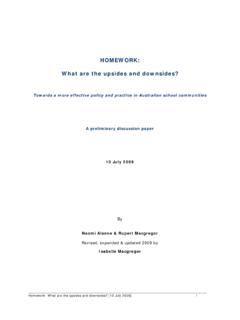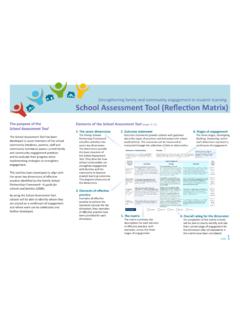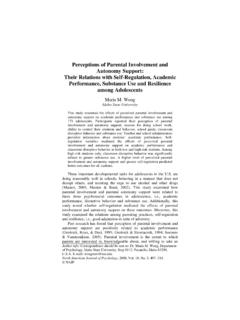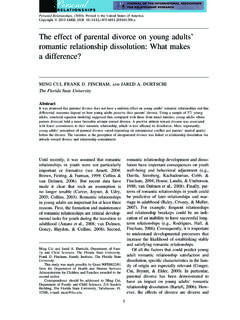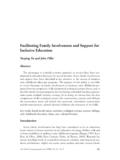Transcription of A Vision of Home-School Partnership
1 A Vision of Home-School Partnership : Three complementary conceptual frameworks Rollande Deslandes Dr Deslandes is a professor at the Universite du Quebec a Trois-Rivieres, Quebec, Canada. This paper was presented at the ERNAPE Conference 2001and published in the proceedings: A Bridge to the Future - Collaboration between Parents, Schools and Communities (2001) ed. F. Smit, K. van der Wolf & P. Sleegers. ITS Stichting Katholieke Universiteit to Nijmegen NL this entire publication is accessible online at For further information about ERNAPE the European Research Network about Parents in Education see their Website at: A Vision of Home-School Partnership : Three complementary conceptual frameworks Rollande Deslandes [Dr Deslandes is a professor at the Universite du Quebec a Trois-Rivieres, Quebec, Canada.]
2 This paper was presented at the ERNAPE Conference 2001and published in the proceedings A Bridge to the Future - Collaboration between Parents, Schools and Communities (2001) e. F. Smit, K. van der Wolf & P. Sleegers. ITS Stichting Katholieke Universiteit to Nijmegen NL and is accessible online at ] This presentation aims to examine the complementary nature of three conceptual frameworks of Home-School Partnership . Epstein s (1987) overlapping spheres of influence model illustrates a global and holistic Vision of Partnership .
3 The model of parental involvement designed by Hoover-Dempsey and Sandler (1995, 1997) adds to understanding by focusing on parental sense of efficacy and parental role construction. The enabling and empowerment model (Bouchard, 1998; Dunst et al., 1992) focuses on the influence of attitudes and behaviors within parent-teacher interactions in a reciprocal Partnership . A Vision of collaborative Partnership appears to prevail in Quebec schools at the moment. Despite some reported difficulties, however, reciprocal Partnership represents a promising avenue.
4 The school -family relation is currently a topic of interest among parents, teachers, policymakers and all those involved in childhood education, as is made clear in a report of the OECD (1997) and a Notice of the Conseil sup rieur de l ducation (1998). It is the subject of a number of researches at the provincial, national and international levels as well ( , Bouchard, 1998; Epstein, 1996, 2001; OECD, 1997; Pourtois & Desmit, 1997; Vincent & Tomlinson, 1997). A study of both theory and practice highlights a trend towards parental involvement , while the prevailing political discourse aims to develop collaboration - Partnership , even - between schools and families.
5 Amendments to Quebec s Education Act in December 1997, for example, affirmed that parents were partners in school management by virtue of their participation in the school council. Those in favor of the Partnership approach cite the results of several researches demonstrating the benefits of collaboration, notably, an improvement in school grades, behaviors and attitudes (Epstein, 1996). Not everyone agrees with this approach, however, especially those who view Partnership as a means of maintaining teachers professional control by considering parental support as an option (Vincent & Tomlinson, 1997).
6 Still others deplore the predominance of a Vision of school -family collaboration dictated solely by the school and its teachers, insisting that a one-way Partnership is not viable (Vincent & Tomlinson, 1997). Lareau (1996), for her part, categorically rejects a concept of Partnership based on equal status, since she believes teachers should have greater power than parents. Cochran and Dean (1991) call for compensatory programs of parent education as well as interventions based on enabling and empowerment (Dunst et al., 1992).
7 For Bouchard (1998), however, these two last principles meet the very definition of Partnership as .. the actualization of the resources and competencies of each (p. 23) (free translation). In a similar vein, the OECD (1997) describes Partnership as ..a process, since it involves learning to work together and valuing each partner s positive contribution to the relationship (p. 58) (free translation). During training sessions for teachers and human service practitioners, we often encountered questions such as the following: What do you do when the parents you want to see never come to the school ?
8 Or What can be done to attract parents who are difficult to reach? This led us to reflect upon the notion of Partnership that now prevails in schools in Quebec and upon how this model of Partnership corresponds to the one advocated by various educational organizations. The present communication will examine the complementary nature of the three conceptual frameworks related to Home-School partnerships: the model of overlapping spheres of influence (Epstein, 1987), the model of parental involvement (Hoover-Dempsey, 1995, 1997) and the family enabling and empowerment model (Bouchard, 1998; Dunst et al.)
9 , 1992). Of the three, the model of parental involvement (Hoover-Dempsey, 1995, 1997) will be given particular attention because of its concern with the problem of difficult-to-reach families. Finally, we will take a look at the type of Partnership that now exists in several schools in Quebec, more specifically at the secondary level. Our view of genuine Partnership is one based on mutual trust, common goals and two-way communication. To collaborate is to participate in the accomplishment of a task or the assumption of a responsibility.
10 Partnership is therefore a collaborative relationship between two parties, and parental involvement is a means of establishing it. Certain authors use the term reciprocal Partnership to describe a mutual sharing of tasks or responsibilities, and the term collaborative or associative Partnership to describe a situation where a task or responsibility is assumed at the request of the school and its teachers (Bouchard, 1998; Boutin & Le Cren, 1998; Dunst et al., 1992; Epstein, 1992).
